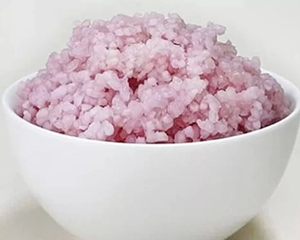Scientists at South Korea's Yonsei University have created a aromanew type of hybrid rice that not only has a meaty pink color but is also packed with beef protein and fat cells.
韩国延世大学的科学家们日前培育出了一种芳香的新型杂交水稻,这种大米不仅呈现肉色,而且还富含牛肉蛋白质和脂肪细胞。
The new pink rice has 8 percent more protein and 7 percent more fat than regular rice,
这种新型粉米的蛋白质含量和脂肪含量分别比普通大米高出8%和7%,
and while it doesn't yet taste like beef, it does carry a "unique blend of aromas, including a slight nuttiness and umami which are characteristics of meat".
虽然吃起来没有牛肉味,但它确实带有一种“独特的混合香味,包括肉类特有的轻微的坚果味和鲜味”。
Thanks to the integrated animal cells, this new pink rice could one day become a complete meal by itself, ensuring a sufficient, sustainable food supply for the whole world.
由于融入了动物细胞,这种新型粉米有朝一日将能凭一己之力成为完整的一餐,确保全世界有充足的、可持续的食物供应。
So how does one go about infusing rice with beef?
那么是怎样将大米和牛肉结合在一起的呢?

Well, knowing that lab-grown cells need artificial scaffolds to create tissue, researchers at Yonsei University decided that the porous nature of rice would make ideal scaffolding.
了解到实验室培养的细胞需要人工基质来形成组织后,延世大学的研究人员认为大米的多孔性是理想的培养基质。
To help the beef cells latch onto the rice grains, the latter were coated in fish gelatin and left to culture in a petri dish for up to 11 days.
为了帮助牛肉细胞附着在米粒上,米粒被涂上鱼明胶,并在培养皿中培养了11天。
The hybrid grains are more firm and brittle than natural grains, and when cooked they retain their traditional appearance.
这种杂交谷物比天然谷物更坚硬、更脆,煮熟后仍能保持其传统外观。
While the rice doesn't really taste like beef yet, it "offers a pleasant and novel flavor experience," and pairs well with a variety of dishes.
虽然这种大米尝起来还不像牛肉,但它“给人一种愉快而新奇的味觉体验”,与各种菜肴搭配都很好。
For now, the percentage of protein in the hybrid rice is still relatively low.
目前,这种杂交大米的蛋白质含量还相对较低。
To actually replace meat, researchers would need to increase protein content significantly.
要真正取代肉类,研究人员需要大幅提升其中的蛋白质含量。












